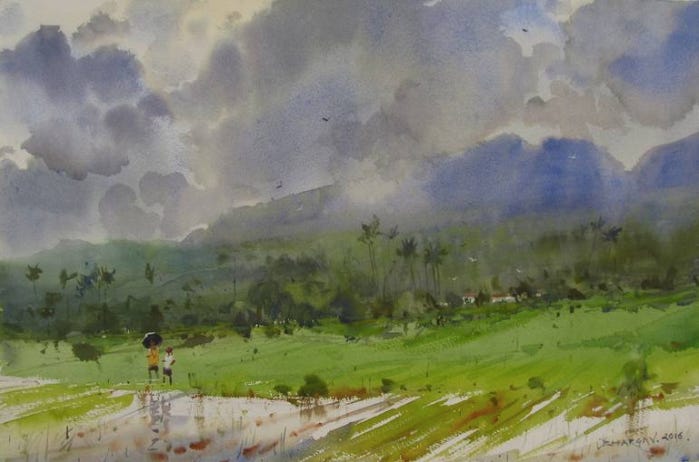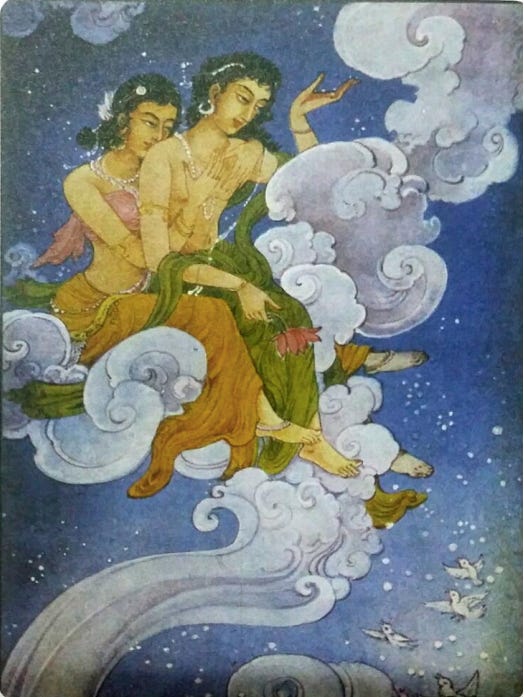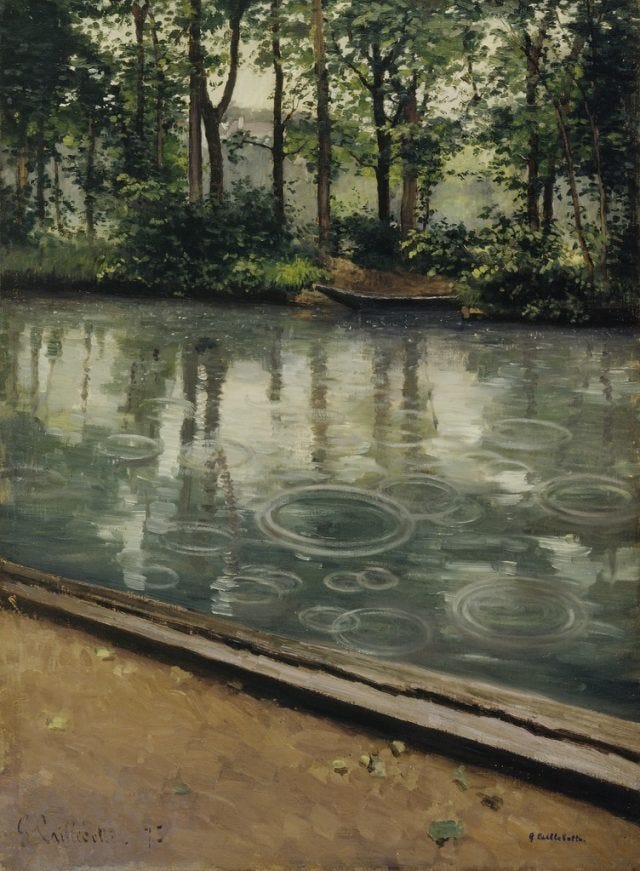The Indian monsoon is a deep rooted meteorological event that seems to dominate the seasonal rhythm of the subcontinent. According to Brittanica, “it is the most prominent of the world’s monsoon systems, and [...] blows from the northeast during cooler months and reverses direction to blow from the southwest during the warmest months of the year, bringing large amounts of rainfall to the region during June and July.”
For me, monsoons draw up a vivid image of thunderstorms towards the end of the hot summer months, cool breeze blowing on the face, and the sudden outburst of big droplets of water, splashing on parched people and places. If you haven’t experienced monsoons in India, I beg you to. It’s a secret travel tip. The flights are cheaper, tourists are fewer, places are greener and people are calmer. Don’t go to cities though. Monsoons bring out the worst traffic sense in an already anarchist traffic system.
There’s something special about rains that make you want to throw away the usual state of routine and do something fresh. Sleep a little longer in the morning, curled up with a beloved as the rain pitter patters outside. An inner voice grateful that you have a warm, dry place to be in. Monsoons are to blame for that extra cup of chai, spiced with freshly grated ginger. A balmy sting as the sweet, hot chai flows down your throat. And food? Bring out the fried stuff and the soups. Samosas, pakodas, batata wadas, manchow soup, rassam, and, and, and….
(Runs to get myself a snack)
“What the four seasons of the year mean to the European, the one season of the monsoon means to the Indian. It is preceded by desolation; it brings with it hopes of spring; it has the fullness of summer and the fulfillment of autumn all in one.”
― Khushwant Singh, I Shall Not Hear the Nightingale
The rains are truly meant to nurture that creative part in our souls. The dark canopy of clouds, thunder, lightning, whooshing winds and the life-giving rim jhim of the rains have stirred up emotions and been a source of inspiration since time unknown! Poetry, paintings, dance, stories, love, solitude - all of it belongs to the ceaseless rainy days. Blank pages seem to be waiting to be written on. Imagination left to run free in the confines of homes and minds.
The Sanskrit poet Kalidasa, who was active in or about the fifth century (Basham, 1959, p. 419) was no different. His poem Meghadūta (the cloud messenger) has survived and been passed on for thousands of years! The drama of the monsoons also extends to music and is displayed gloriously in Indian classical music inspiring at least 36 ragas classified as raga Malhar. Chanchal Uberoi explains in his research paper titled ‘The melodies of monsoons: Weather in Indian classical music’ that the name Malhar is derived from the Sanskrit words mala and hari, which literally means “uncleanliness remover”. And true to its name, the raaga and the various melodies associated with it really do feel powerful enough to wash away the dirt from our minds.
Like literature and music, monsoons have found an innate expression in dance too. So much so that across the Indian subcontinent, there are hundreds of folk and classical dances as homage to the rains! The myriad cultural traditions in India have truly eulogised monsoons as a time to reconnect with nature - the nature that exists outside but also the nature that exists within oneself.
Today’s newsletter is an ode to this monsoon state of my mind. Addressing the inner and outer thunderstorms, here’s some poetry, prose, music and art to remind you of petrichor, of muddy puddles and paper boats.
Poetry
Obviously starting with Mary Oliver.
Last Night the Rain Spoke To Me By Mary Oliver
Last night the rain spoke to me slowly, saying, what joy to come falling out of the brisk cloud, to be happy again in a new way on the earth! That’s what it said as it dropped, smelling of iron, and vanished like a dream of the ocean into the branches and the grass below. Then it was over. The sky cleared. I was standing under a tree. The tree was a tree with happy leaves, and I was myself, and there were stars in the sky that were also themselves at the moment, at which moment my right hand was holding my left hand which was holding the tree which was filled with stars and the soft rain— imagine! imagine! the wild and wondrous journeys still to be ours.
Time by Alex Dimitrov
Again I am unprepared standing under an awning in the middle of summer autumn, winter, spring-- watching the downpour in what could be the middle of life; wondering how long I'll wait before becoming the rain.
A haiku by Santôku
Le chardon brille Dans le matin Après la pluie Translation: The thistle shines In the morning After the rain
Monsoon Nights by Vijayalakshmi Harish
My dreams are the texture of the earth softened by the monsoon a clairvoyant fragrance rises from the green sprouts pushing their way through-out and through-in my rain-coloured mental canvas a cool drop snakes down my ready spine i’m dissolved in the frissons that ensue even as your warmth embraces me every numbing night the winds detach the flowers from every mourning tree and I give you myself as you rain on me incessantly
Advice from a Raindrop by Kim Stafford
You think you’re too small to make a difference? Tell me about it. You think you’re helpless, at the mercy of forces beyond your control? Been there. Think you’re doomed to disappear, just one small voice among millions? That’s no weakness, trust me. That’s your wild card, your trick, your implement. They won’t see you coming until you’re there, in their faces, shining, festive, expendable, eternal. Sure you’re small, just one small part of a storm that changes everything. That’s how you win, my friend, again and again and again.
MUSIC
Since I referred to Raag Malhar above, I thought I’d put something that helps you deconstruct and understand how a raag is learnt. Here’s one of my favourites - Raag Megh Malhar.
Links, Reading and Brain Fodder
Stumbled upon this wonderful academic pursuit while researching for this week’s post - Monsoon Feelings: A History of Emotions in the Rain
A rainy day with Ruskin Bond (P.S. I adore this gem of a human and his writing. Please make it a point to read any of his books if you are looking for some simple, nostalgia-driven reading.)
Blob Opera: Create your own opera inspired song! A machine learning experiment by David Li in collaboration with Google Arts & Culture.
Hope you enjoyed reading this rainy post. Go grab yourself a cup of tea and a cozy armchair and share this with someone you think might enjoy reading!
Also, don’t forget to subscribe if you haven’t already done so. That way, you can get notified whenever I put a new post out! Thanks for all the love. xoxo






So nicely written. For a moment I thought I am enjoying this rain and calling for hot Pakoda and ginger Tea....... This is the best season I enjoy real nature